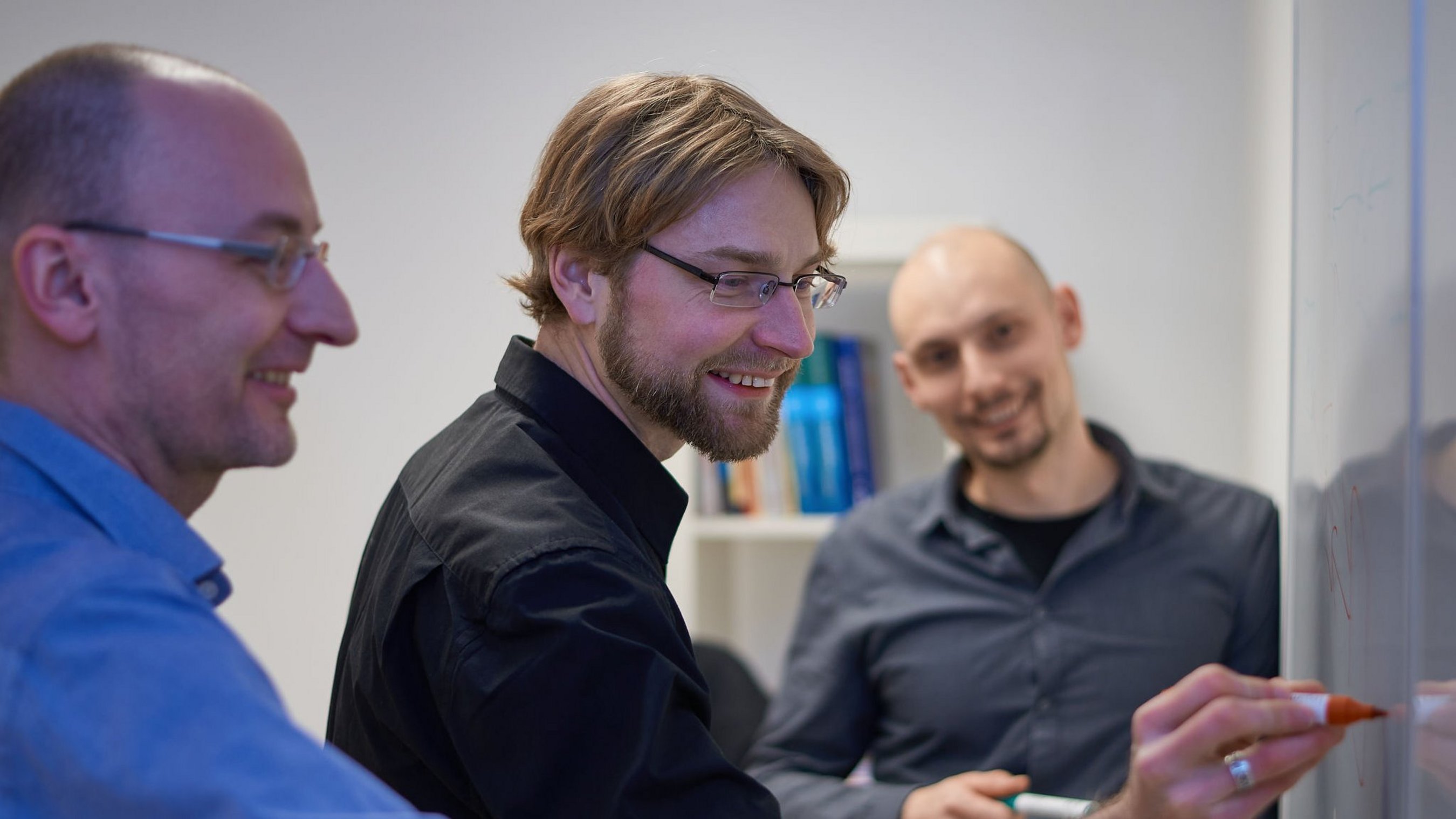Digital twin in mechanical engineering
STIWA as leader due to close partnership with research
STIWA as leader due to close partnership with research
STIWA as leader due to close partnership with research
The digitalization of production systems is one of the most important topics for machine manufacturers and production companies today. STIWA operates in the field of networked product and high-performance automation since 25 years and especially benefits from the unique selling point of being machine manufacturer, producer and software developer. At the same time STIWA relies on active cooperation with research institutions. In the following interview our research partners - Arndt Lüder, Managing Head of the Institute of Ergonomics, Manufacturing Systems and Automation of the University in Magdeburg, Stefan Biffl, Professor at the Institute of Information Systems Engineering at the TU Vienna and Edgar Weippl, Professor for IT Security at the University of Vienna and Research Director of the SBA Research Center - show the the added value of research for Industry 4.0 and explain why specifically STIWA is the ideal partner for this.
Why is it important from your point of view, that research concerns itself more with the production of the future?
Production companies have different applications for Industry 4.0 in mind. They reach from improved monitoring, diagnostics and maintenance support to an automatic process optimization or self organization with maximum machine flexibility.
To cope with these challenges, machine manufacturers on one hand need suitable reference architecture for their machines that meet the requirements of the machines functional structuring and allow the creation and utilization of machine components. These components are to be equipped with sufficient intelligence. This intelligence can occur in the component itself or in a external data processing assigned to the component (or in both).
Machine manufacturers on the other hand need a methodology to compile all the relevant information for the mentioned use cases and assign the component as a digital copy, digital shadow or digital twin and therefore use the intelligence assigned to the component. It must be irrelevant here, from which life cycle phase of the machine (engineering, start-up, utilization, ...) the relevant information originates.
According to this the machine manufacturers have to concern themselves with the functional machine structures and information during the entire life cycle of these machines and understand what application of Industry 4.0 can generate benefits based on which structures.
And incidentally another critical challenge is on its way to us: the topic of information security, Cyber Security. Rising digital capabilities and increasingly available information models allow for new types of attacks on production systems. Machine manufacturers have to life up to this task during the design of their machine structures and information models and establish the appropriate technical as well as organizational safety structures throughout the entire machine life cycle.
These challenges require research at the universities in cooperation with machine manufacturers.
Why is STIWA in this area an interesting partner for you?
To be a good partner for research, three qualities in a company are important. On one side the company itself has to possess a distinctive innovation culture, in the scope of which sometimes even inconvenient ways and topics can be researched and their utilization (or non-utilization) for a company or specific systems established. Furthermore the company has to have reached a sufficient maturity level in the area of engineering. Examples are a lived model based system design, recognized consistent design processes and a corresponding tool landscape. Thirdly a certain application range, meaning a larger quantity of different industrial areas where customers come from and therefore the developed machines can be used, have to be named. This enables a wider validation of the research findings.
All these characteristics are met at STIWA. In addition, the colleagues of STIWA always strive for a trustworthy and friendly climate of cooperation, which makes research not only exciting but also increasingly successful for both sides.
Which projects are currently worked on in the course of this research cooperation?
Topic background of the research cooperation are the consistent design of production systems and the thereby necessary Cyber Security of the machine as well as in the design process. This very complex subject area can not reasonably be worked on all at once. Initial comprehensive considerations of the model based design of production systems, thereby vital information and its structuring along the tool chains from the point of view of the involved engineering disciplines as well as of the designed assets are necessary, as well as corresponding information models. Here the goal must be to create an infrastructure that provides an integration of all design information up to a digital copy (and later on a digital shadow or a digital twin) for all machine components, such that all parties involved in a machine project can use this wealth of information beneficially.
Once this step is taken, many potential benefits can be collected. Examples, that we and STIWA currently collaborate on, are the explicit utilization of product-process-resources (PPR) models, i.e. the connections between material lists, manufacturing regulations and resources to be used for identification of reusable function units for engineering and improvement of the interaction between engineers in basics and detail engineering or the identification of Cyber Security aspects. The in-depth research in this area enables STIWA to realize complex and high-quality machines in very short lead times.
“Digital twin”, “digital shadow” and “digital copy” are currently often quoted terms in mechanical engineering or machine operation. What is actually meant by this?
A requirement for the digitalization are information structures that depict the knowledge about this system. Three terms are very widely used at the moment.
The digital copy is a digital model of a physical, technical system, that describes said system. No direct dependency exists between the physical system and the digital copy. Therefore the digital copy can already be available while the physical system does not yet exist, does not exist anymore or has changed. Thusly the digital copy is predestined for the utilization in the design phase of a technical system to aggregate all information step by step that are necessary for the later successful realization and usage of the physical technical system.
The second term is the digital shadow. It is connected to the physical technical object unidirectional, i.e. It changes when the physical object changes. Therefore it maps the structure, status and behavior of the physical technical system at all times and makes sense in particular if the physical system exists and is used. In doing so the digital shadow can particularly be used for the analysis of a consisting technical system, for example for behavior forecasting (simulation).
The third term is the digital twin. Other than the digital shadow it is connected bidirectional with the physical technical object. The digital twin (a) changes when the physical object changes and (b) causes a change at the physical object with its own change. Thusly it not only enables an analysis of the physical object but also a retroactive effect of the analysis results.
To meet the requirements of Industry 4.0, all three roles have to be targeted.
Where, from your point of view, will the future take you?
Engineering data form a wealth of knowledge. They can help to enhance efficiency and effectiveness in different ways, in the design of the production systems as well as in their operation and disassembly. This wealth of knowledge will improve more and more. Here Industry 4.0 will play an important role.
This way digital copies of components of designed or existing production systems can be compared and evaluated based on their similarity. This way reliable, reusable components can be gained and used in a quality-assuring way in the design process. There will certainly be a lot of friction here that results from the familiar paths of end users, such as popular structures or programming requirements. The joint quality and cost gain will hopefully lead to a standardization of structures and programming methods encompassing many companies.
Another example is the support for information acquisition for Round-Trip-Engineering. Changes in machine structures for example must be included in the models of the security analysis (e.g. FMEA) or the IT security analysis. Here networked models can facilitate work, accelerate it and ensure technical security based on the digital copies.
The wealth of knowledge can also be used for optimization of product quality or an evaluation of IT security properties.
But the most important requirement of all these utilizations is the realization of efficient methods for collecting and integrating engineering data from all relevant engineering disciplines and their consolidation to networks of digital representation for products, processes and product resources (PPR). Here methods and technical solutions must increasingly be created in the future, that meet the requirements of the different companies and their working methods. There probably won’t only be one preferred solution.
The machine process includes various disciplines (mechanical system, electronics, software): How can transparent processes for a generally applicable data base across all disciplines be ensured? Especially regarding the backflow of information from detailing to rough planning.
The machine development process is a multi-disciplinary process by design, in which different models are created in the involved engineering disciplines step by step and partially iterative which have to be shared. Here design data logistics can and have to be used, which not only ensure the pure exchange of the created models or documents, but also develop contents and concentrate them to a closed and consistent world of knowledge of the designed machine components up to sensors and actuators.
This world of knowledge is the wealth of knowledge mentioned above. It must follow the idea of the digital copy and put the different copies of machine components in relation to each other. From it the information can be extracted that are needed for a design discipline. With it any desired forward and backward movements can be realized in the design data flow, including Round-Trip All information always rely on a common consistent data base.
The implementation of data logistics of this kind can be managed without modification of the design tool. It requires awareness about the machine objects that are relevant in each respective design disciplines and their described properties and relations. They have to be concentrated once to one common understanding relevant to the related tool chain and can then be used for the configuration of model transformations towards a data model inspired by the Industry 4.0 management shell. This creates a data backbone that will prove to be an enormous wealth of knowledge.
How can the IT security aspect be integrated in the entire machine process?
IT security is something, that has to be viewed holistically in a production system. Besides international and national norms, there are procedure models that require the consideration of the machines from the point of view of their vulnerability. This requires enough accessibility to the knowledge about the structure and behavior of the production system. The wealth of information mentioned above from the machine engineering contains this knowledge and therefore has to be put to use accordingly. This requires the IT security engineering to not just be a appendage, but an integral part of the machine design.
It is beneficial that for the implementation of IT security measures the idea of reuse is of big importance. It can be resorted to components in machine design that already have IT security concepts which are documented in the digital copy accordingly, then the realization of the complete concept is not only quicker, but also more secure and easier to certify where necessary.
Thank you for the interview!
Apl. Prof. Dr.-Ing.habil. Arndt Lüder
Managing Head of the Institute of Ergonomics, Manufacturing Systems and Automation
Chair of Production Systems and Automation
More Infos
Ao. Univ.Prof. Dr. Stefan Biffl
Professor at the Institute of Information Systems Engineering at the TU Vienna
Link for more information: https://qse.ifs.tuwien.ac.at/people/stefan-biffl/
Univ.-Prof. Dipl.-Ing. Mag. Dr. techn.Edgar Weippl
Professor for Security and Privacy at the University of Vienna sec.cs.univie.ac.at
Director of the CD-Laboratory for Security and Quality Improvement in the Production System Lifecycle (Christian Doppler Research Association), Research Director of the SBA Research Center, private lecturer at the TU Vienna
Link for more information: https://informatik.univie.ac.at/forschung/projekte/projekt/322/



